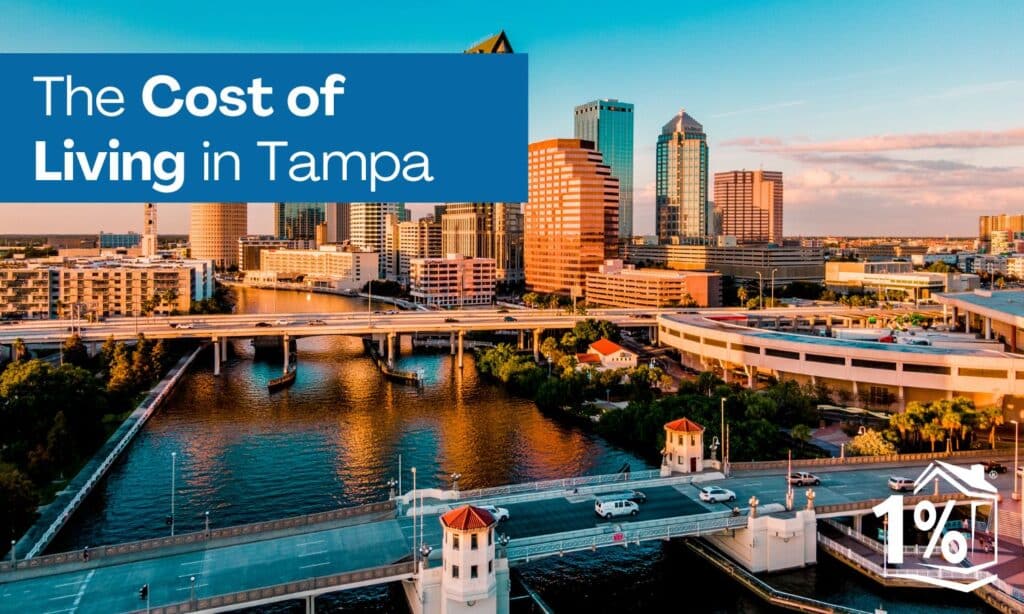Tampa is recognized as the economic hub of western Florida, boasting a vibrant mix of tourist attractions and professional sports teams across three major leagues. This area is also celebrated for its stunning Gulf Coast beaches and enjoys nearly 250 days of sunshine each year. With a wealth of indoor and outdoor activities available for families of all ages, Tampa is an inviting place to call home.
Tampa’s history dates back to the 19th century, beginning with the establishment of Fort Brooke after the U.S. acquired Florida from Spain. Tampa was officially incorporated in 1855, but its growth was initially slow. However, by the 20th century, Tampa had emerged as a modern center of trade, finance, and commerce.
If you’re considering relocating to Tampa, it’s essential to have a clear understanding of the living expenses you can expect. Continue reading to explore the cost of living in Tampa and how much you’ll need to live comfortably in this dynamic city.
What Are Tampa’s Living Expenses?
The cost of living in Tampa is about 4% higher than the national average. Residents typically spend around $4,711 per month, which equates to $56,532 annually.
Let’s break down these costs by category.
Rental Costs in Tampa
Based on our data from Apartment List, the average rent for a one-bedroom apartment in Tampa is $1,364, while a two-bedroom averages $1,680. The city’s rental prices have seen a slight year-over-year decrease of 0.9%.
Housing Market in Tampa
Tampa’s housing market has also been experiencing steady growth, with the median home price sitting at $231,800. For comparison, median home prices are $398,100 in Miami, $294,400 in Orlando, and $231,000 in Jacksonville. Of course, which of the Tampa neighborhoods you choose can affect the price substantially.
Search homes for sale in Tampa here.

What Income is Needed to Live Comfortably in Tampa?
Understanding the type of lifestyle you wish to maintain in Tampa is crucial to determining your ideal salary. The minimum living wage in Tampa is approximately $17.17 per hour, which covers basic necessities like housing, food, and other essentials. This wage assumes a very modest lifestyle and does not include additional expenses such as dining out or attending live sporting events. According to the U.S. Census Bureau, the median household income in Tampa stands at $59,893.
It’s important to note that living wage, median household income, and the recommended salary are distinct concepts.
To calculate a recommended salary for living comfortably in Tampa, consider applying the 30% rule for rent. This guideline suggests that no more than one-third, or 30%, of your gross income should be allocated to rent. For instance, if your rent is around the median cost for a one-bedroom apartment in Tampa at $1,346, your monthly income should ideally be at least $4,486, translating to an annual income of $53,832.
While this recommended salary might seem achievable, it caters to a very basic lifestyle, similar to the living wage. To fully enjoy what the city has to offer, you might need to aim for a higher salary, seek a more affordable apartment, or consider a combination of both.
Fortunately, typical annual salaries for common professions in Tampa are quite competitive. The highest average salaries are found in Management, Computer and Mathematical roles, as well as Architecture and Engineering.
Transportation Costs in Tampa
Tampa offers various public transportation options through the Hillsborough Area Regional Transit Authority (HART). The TECO Line Streetcar, for instance, connects Channelside Bay Plaza with the historic Ybor City, with multiple stops throughout the downtown area and convention center district.
Fares for HART services range from free (on the TECO Line Streetcar) to $3, depending on the route. There are several payment options available, including 1-day unlimited passes, 31-day unlimited passes, 10-pack 1-day unlimited tickets, 3-day unlimited passes, and monthly passports.
For those who prefer to drive, the annual transportation cost in Tampa for a single adult without children is about $10,334. A family of four, consisting of two working adults and two children, can expect to spend around $17,334 on transportation each year. Unfortunately, gas prices in Tampa are relatively high, averaging around $3.57 per gallon, which is slightly above the national average of $3.79.
Food Costs in Tampa
Tampa is a culinary melting pot, offering a rich blend of cuisines influenced by cultures from around the globe, including Cuba, Spain, Italy, the Southern United States, Mexico, and Asia. When you live in Tampa, there are a few must-try dishes, such as the Tuscan Frittata from Pinky’s Diner, fresh seafood from Oystercatchers, and the Blackened Grouper Reuben sandwich at Skipper’s Smokehouse.
Dining out in Tampa can be quite affordable, with an average meal at an inexpensive restaurant costing around $22. For those seeking a more upscale dining experience, a three-course meal for two at a mid-range restaurant will typically set you back about $60, excluding alcohol and dessert.
Grocery costs in Tampa are also reasonable. A single adult without children can expect to spend approximately $3,351 annually on groceries. For a family of four with two working adults and two children, the yearly grocery bill is about $9,856.
When shopping at local grocery stores like Whole Foods Market, Publix, or Sprouts Farmers Market, you’ll find prices that are comparable to or slightly below the national average. For instance, a gallon of regular milk costs about $4.14, just slightly above the national average of $3.85.

Healthcare Costs in Tampa
Health is a priority no matter where you live, and understanding healthcare costs is essential when considering relocating. Whether you have minimal healthcare needs or require regular medical visits, having health insurance in Tampa can help manage your expenses and ensure you can access the care you need in case of an emergency.
Healthcare should always be a key part of your budget planning. In Tampa, a single adult without children will spend around $2,871 annually on healthcare. A family of four, with two working adults and two children, can expect to pay about $9,758 per year for medical expenses.
Fitness and Entertainment in Tampa
Tampa offers a wealth of fitness and entertainment opportunities, with its year-round sunshine making it easy to enjoy outdoor activities. However, Tampa’s hot summers can be intense, so joining a local gym might be a good idea for staying active indoors. Fortunately, fitness club memberships are reasonably priced, with monthly fees averaging $29.50 for one adult.
For entertainment, catching a movie at a local cinema will cost you around $14, not including snacks or drinks. Sports enthusiasts can enjoy watching the NFL’s Tampa Bay Buccaneers, the NHL’s Tampa Bay Lightning, or the MLB’s Tampa Bay Rays. Additionally, six other MLB teams hold their spring training in Tampa, offering even more opportunities for sports fans.
Tampa is also home to numerous affordable entertainment options. You can explore the city’s museums, such as the Tampa Museum of Art, the Glazer Children’s Museum, or the Museum of Science and Industry. For those who prefer outdoor activities, Tampa has several parks to enjoy, including Lettuce Lake Park, Ballast Point Park, and Anderson Park.
Additional Expenses to Consider in Tampa
If Tampa’s year-round sunshine isn’t enough to attract you, the low tax burden might be the deciding factor. One of the main reasons people are drawn to Florida is the absence of a state income tax. However, residents are still responsible for some minimal taxes. In Tampa, the sales tax rate combines Florida’s state sales tax of 6% with Hillsborough County’s 1.5% sales tax, totaling 7.5%.
When planning your move to Tampa, be mindful of other potential expenses, especially if you’re relocating from out of state. These can include transportation, hotels, storage, and hiring cross-country movers.
Big moves like this often come with additional fees, such as pet deposits, security deposits, apartment application fees, and other potential costs. Don’t forget about the expense of furnishing your new place, which is another factor that can quickly add up. If you’re concerned about managing your budget, you can explore tips on decorating your apartment on a budget. Being aware of these possible costs allows you to plan and adjust your budget accordingly.

Job Market in Tampa
Tampa’s job market is slightly less robust compared to other metropolitan areas of similar size. The city’s largest employers include MacDill Air Force Base and Publix Super Markets. Other significant employers include educational institutions like the University of South Florida and healthcare providers such as BayCare Health System.
Tampa’s unemployment rate currently stands at 2.6%, which is 0.9% lower than the national average. While the pandemic had a notable impact on the job market, Tampa is steadily recovering as businesses continue to reopen.
FAQs about Tampa’s Cost of Living
How expensive is it to rent an apartment in Tampa, FL?
The median rent for a one-bedroom apartment in Tampa is $1,364, while a two-bedroom apartment costs $1,680.
What is the most affordable rent in Tampa, FL?
The most affordable rental option in Tampa is a one-bedroom apartment, with the median rent being $1,404.
What is the population of Tampa, FL?
According to the U.S. Census Bureau, Tampa has a population of 387,050, making it the third most populous city in Florida.
If you’re ready to start looking for your next home in the Tampa area, and need an experienced Realtor, call us today!

